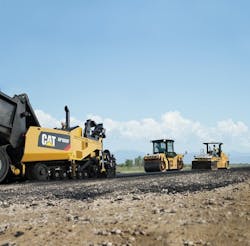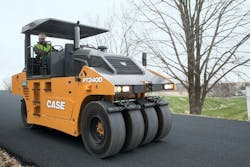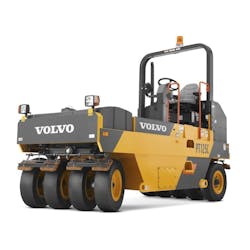How to Choose Pneumatic Tire Rollers
Pneumatic-tire rollers can find utilization a number of ways on asphalt and soil.
What to look for in pneumatic tire rollers
“Rubber-tire rollers range from 5 tons all the way up to 30 tons, and within that there’s a variety of different sizes, different weight categories, and different tire sizes,” says Tim Kowalski, Hamm’s applications support manager. “You can use them anywhere from compacting soils to chip seals to hotmix, depending on where you want to work.
“Some states are a little bit different as far as either requiring them or not requiring them, but where they really shine is in areas where you may be putting hotmix down and you have a lot of catch basins, water mains, or manhole covers,” Kowalski says.
“The rubber tires have a tendency to knead that material around those versus a steel drum that actually bridges on top of them,” Kowalski says. “We see a lot better compaction effort in those areas. Also, you can get up to a 30-ton roller, which is one of the heaviest rollers that you can get, to test where soft spots possibly are on the soil side. You can also use those as breakdown rollers, and in areas where you can’t use vibration. A lot of times the kneading action on the tires will help you get initial compaction as well.”
Kowalski says there are some limits for managers to be aware of.
“A lot of the new polymer-modified or rubber-modified asphalt doesn’t really work too well with rubber- tire rollers; the polymer and the rubber that’s in the asphalt itself reacts and has a tendency to stick a lot more to the rubber-tire rollers,” he says.
Because of this potentially sticky situation, Kowalski says there are different release agents available to prevent buildup on tires, but he has not heard of one that works well with polymer- or rubber-modified asphalt.
“It’s tricky trying to get the right temperature to reduce that amount of buildup on the tires,” Kowalski says. “In those situations, I know a lot of oil manufacturers don’t really recommend use of rubber-tire rollers on those types of oils, but sometimes the state requires it and you don’t have much choice.”
What to ask with buying a pneumatic tire roller
When buying a pneumatic-tire roller, manufacturers suggest asking a number of questions based on the application.
“Are you working a course mix, a fine mix, or thinner lifts or thicker lifts?” Kowalski says. “Do you have a lot of hilly areas, or is it mostly just flat? Are you looking to use this in multiple different ways? With some of the newer rubber-tire rollers, we can change the ballasts on them so we can change the weight in the machine.”
Kowalski stresses that pneumatic-tire rollers can be used in soil compaction applications as well.
“So now we can decide whether we want skirts on it if it’s going to be on the asphalt or if we don’t need skirts on it, or if it’s going to be equipped with brushes and scrapers,” Kowalski says.
Also, pay attention to the water tank.
“We offer the option of having an additive tank with a blending pump so we can do different ratios as far as blending an additive with water to spray the tires,” Kowalski says.
He stresses that the scraper system for the tires should be kept in good condition and should properly fit the tires. Any brushes should be kept clean, and the watering system on the roller should be working properly.
“If you have a blending pump and work with some of these [asphalt] additives, and you also know you’re going to be sitting [idle] for a while, you need to make sure you clean the system out so it doesn’t clog up,” Kowalski says.
“It’s easy to fall into the trap of thinking that anyone can run a pneumatic-tire roller when operation of these machines often requires more training and experience than a tandem vibratory roller,” says Caterpillar global sales consultant Cary Bryant.
How to maintain pneumatic tire roller operators
Another area where managers can save money is proper tire maintenance and inflation.
“Regular checks and scheduled maintenance as prescribed in the owner’s manual should always be followed,” Bryant says. “Early detection of any type of issue can help avoid downtime and minimize repair costs. Aggregate base compaction with pneumatic-tire rollers, although very effective, can pit the tires causing problems with material pickup if the machine is moved to an asphalt application. Consider dedicating separate machines to aggregate compaction and asphalt compaction or replace tires before moving a machine from aggregate to asphalt.”
“With tire pressure, it’s understanding that all those tires need to be at the same pressure depending on what the weight of the machine is,” Kowalski says.
“If there’s too much pressure, then you get too much of a knifing effect on the material and it just moves it around and doesn’t allow it to compact like you want,” he says. “If you don’t have enough pressure, then it actually looks like a flat tire on the machine and it tries to cup that material underneath the tires.”
Managers should be sure to check the guidelines available from tire manufacturers.
“That will give you the type of pressure that you need for the displacement and the contact area that you’re going to have with that tire,” Kowalski says. “And, if you’re going to switch tires because you have one that is damaged, you should maintain the same brand, because a Michelin tire is different from a Dunlop tire. They’re all different because of the type of rubber they use, and the weight and thickness—even though they might be the same size as far as rim and tire diameter.”
Bryant also stresses tire pressure, along with utilizing available technology.
“Proper tire pressures are critical to delivering optimum compaction and surface finish with a pneumatic-tire roller,” Bryant says.
“The CW34 can be equipped with an automatic tire pressure regulating system, which maintains a target pressure across all tires even as tire temperatures fluctuate dramatically throughout the workday,” Bryant says.
“Pass-count mapping keeps operators informed of the number of completed passes. GPC sensors combine with a mapping display to inform the operator when the target pass count is reached. This helps the operator meet or exceed compaction requirements and deliver uniform, target density with maximum efficiency,” he says.
“Temperature mapping helps operators identify their window of opportunity to deliver optimal compaction and avoid material pick-up and other issues that could potentially damage an asphalt mat,” Bryant says. “Additionally, all temperature data is recorded for future analysis and quality-control documentation. Operators are informed of mat temperatures via infrared sensors located on both the front and rear of the machine.”
Pneumatic tire roller market trends
“Covid kind of threw everybody into a whirlwind, but surprisingly enough, we’ve actually been very busy,” Kowalski says. “All manufacturers have been hit as far as getting parts needed for manufacturing, but if anybody’s got equipment, it’s usually selling. We’ve been very successful as far as sales this year, so I would say things have been good. We’ll see how the transportation bill goes; it might even go up further than that.”
At press time, a bipartisan group of senators and the Biden Administration had agreed on the framework of an 8-year infrastructure funding package, potentially replacing what has been a string of short-term funding extensions.
“Usually, with a short-term [package], a lot of people are a little leery of purchasing new equipment,” Kowalski says. “That’s where you’ll probably see more rental equipment used because people aren’t quite sure what to expect as far as jobs coming up. If we start seeing a long-term transit bill, customers are feeling more comfortable on purchasing versus renting. I think you’re going to see a lot more manufacturers selling equipment if we get a longer transportation bill.”
Caterpillar’s Bryant ties pneumatic roller sales success to its versatility.
“In general, we’re seeing some increase in popularity with pneumatic-tire rollers as more contractors have begun to appreciate the value they can add,” Bryant says. “When deployed correctly, and in the right applications, pneumatic-tire rollers can deliver more uniform density and do it more economically—with fewer roller passes—than tandem vibratory rollers.”






